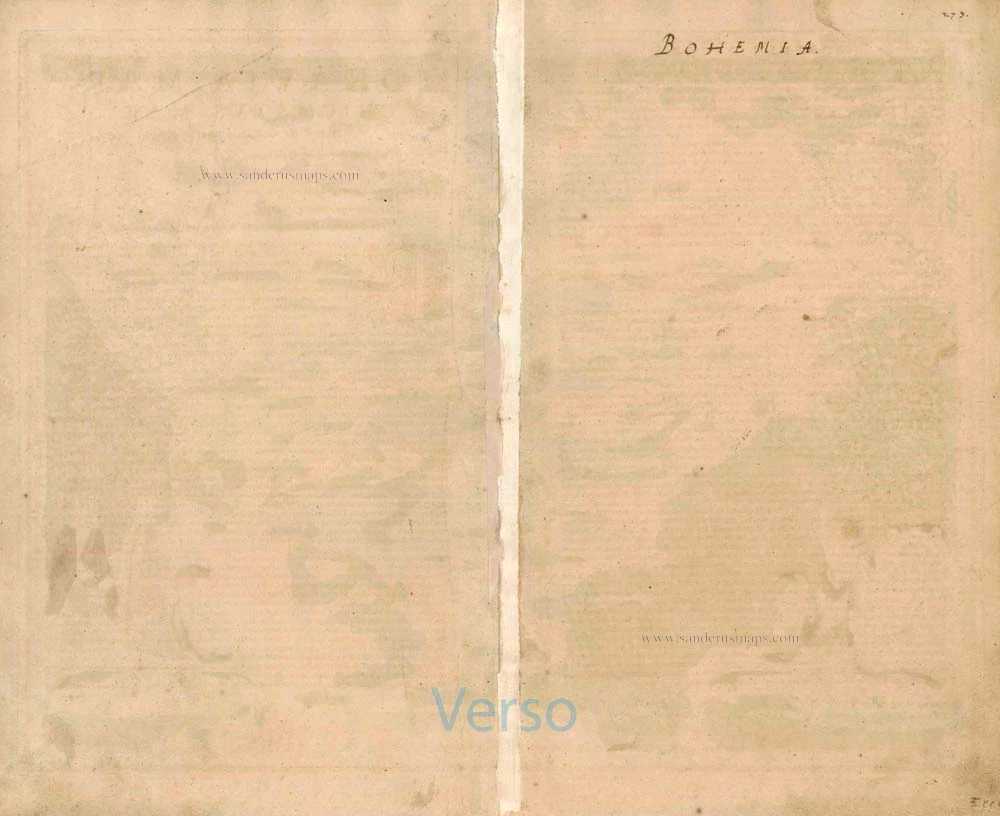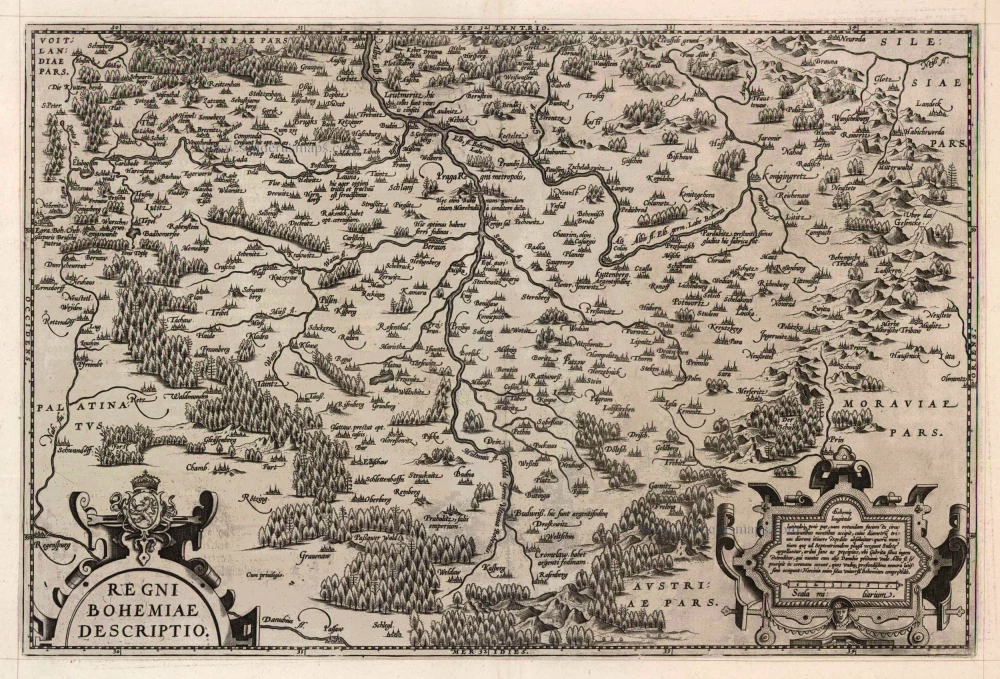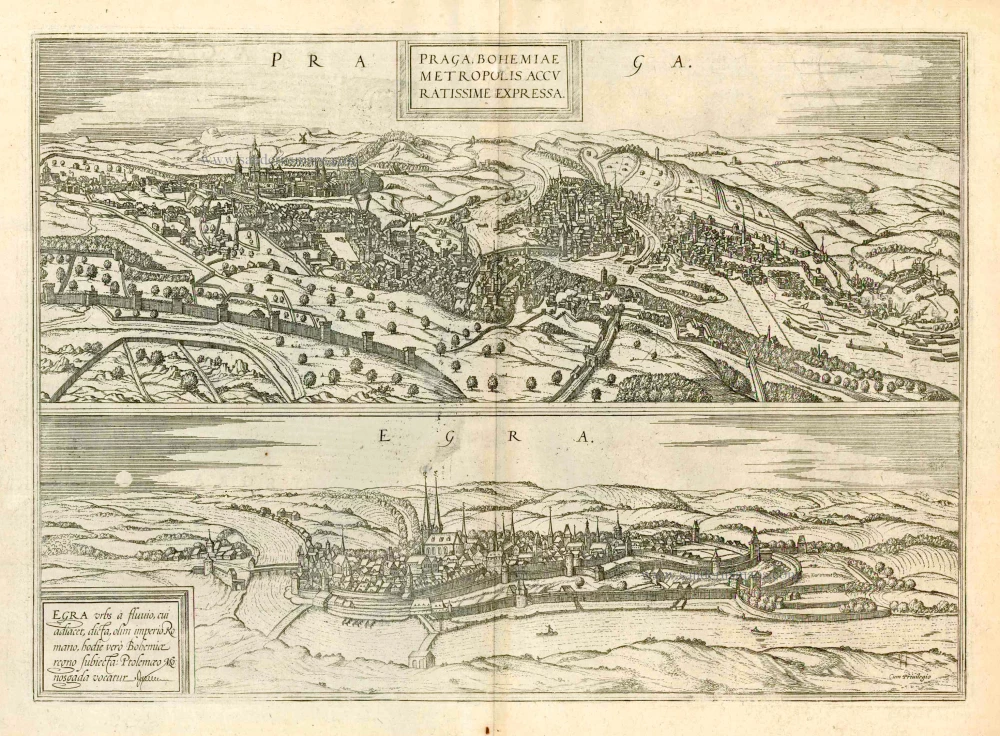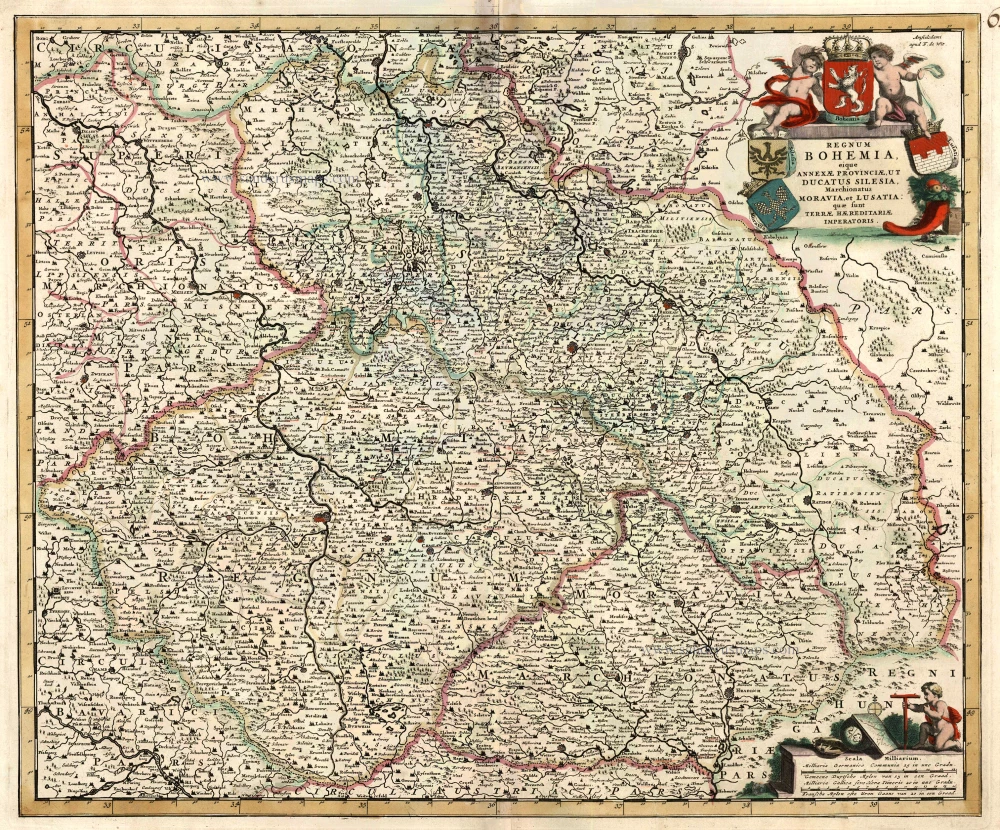Old antique map of Bohemia by P. Van der Keere (Kaerius) 1618
The title runs across the top of the map. In the lower left corner a view of Prague (Praga) is placed, combined with a Latin dedication to Eilhard Lubinus, professor of mathematics at Rostoch University, signed by Van der Keere (Petrus Kaerius Flan.). In the lower right corner - as pendant to the Prague-view - the Imperator's residence (Kaisers Hof) is shown. A costumed couple and a shield with the Imperial coat of arms complete the decoration. Between the cartouche with the scale bar and the view of the Kaisers Hof Van der Keere's 1618 dated imprint is placed.
The geographical content is based on the map of Bohemia in Ortelius's Theatrum orbis terrarum of 1570 on, which goes back to the map of Johann Criginer (1521-1571).
A later edition was published by Everard Cloppenburgh, who was active in Amsterdam as a publisher in the period 1631-41. The imprint on Van den Keere's plate at the bottom is in this edition changed to: Amstelodami Everardus Cloppenburghius excudit. (Schilder)
Pieter Van den Keere (Petrus Kaerius) (1571-c.1650)
Pieter van den Keere was born in Ghent in 1571 as the son of the type-founder, Hendrik van den Keere. In 1584, he moved with his family to London for religious reasons. There, Van den Keere received training as an engraver from Jodocus Hondius, his brother-in-law. Not only the companionship with Jodocus Hondius but also the acquaintanceship with Pieter van den Berghe (Petrus Montanus), author of the text of the Germania Inferior, originates from the years of refuge in London.
Upon their settlement in Amsterdam in 1593, both Keere and Hondius embarked on a monumental project. Their collaboration resulted in the creation of a large wall map of Europe, a masterpiece that still stands as a testament to their skill and vision, dated 1595: Nova totius Europae descriptio.
In 1610, he set up a workshop in the Kalverstraat that he called ‘In den onseeckeren tijd’ (In the uncertain time). During this period, he made numerous copperplates, including maps for his Atlas of the Netherlands and the Atlas Minor published by Jodocus Hondius.
The Germania Inferior (1617) is the first original atlas of the Netherlands published in folio size. The text for the atlas, both in Dutch and in French, was written by Petrus Montanus. After 1623, Claes Jansz. Visscher bought the plates and substituted his name for Kaerius’s. In 1634, Visscher included many of these maps in his Germana Inferior.
Kaerius's fame is not only based on his atlas of the Netherlands. He is even better known as an engraver of many loose-leaf maps and as a collaborator of book publishers. His maps are found, i.e., in the Caert thresoor (Barent Langenes, 1598), Licht der Zeevaert (Blaeu, 1608), Atlas Minor (Hondius, 1628), and Caertboeck vande Midellandsche Zee (Barents, 1595).
Regni Bohemiae Nova Descriptio. // P. Kaerius Excudebat Amstelo: dami Anno à nato Christo 1618.
Item Number: 25264 Authenticity Guarantee
Category: Antique maps > Europe > Central Europe
Old, antique map of Bohemia by P. Kaerius (Pieter van den Keere)
Date of the first edition: 1618
Date of this map: 1618
Copper engraving
Size: 38.5 x 50cm (15 x 19.5 inches)
Verso: Blank
Condition: Contemporary old coloured, small repair at lower centrefold, age toned.
Condition Rating: B
References: Schilder 8, p.548 #40.
Separate publication.
The title runs across the top of the map. In the lower left corner a view of Prague (Praga) is placed, combined with a Latin dedication to Eilhard Lubinus, professor of mathematics at Rostoch University, signed by Van den Keere (Petrus Kaerius Flan.). In the lower right corner - as pendant to the Prague-view - the Imperator's residence (Kaisers Hof) is shown. A costumed couple and a shield with the Imperial coat of arms complete the decoration. Between the cartouche with the scale bar and the view of the Kaisers Hof Van den Keere's 1618 dated imprint is placed.
The geographical content is based on the map of Bohemia in Ortelius's Theatrum orbis terrarum of 1570 on, which goes back to the map of Johann Criginer (1521-1571).
A later edition was published by Everard Cloppenburgh, who was active in Amsterdam as a publisherr in the period 1631-41. The imprint on Van den Keere's plate at the bottom is in this edition changed to: Amstelodami Everardus Cloppenburghius excudit.
The title runs across the top of the map. In the lower left corner a view of Prague (Praga) is placed, combined with a Latin dedication to Eilhard Lubinus, professor of mathematics at Rostoch University, signed by Van der Keere (Petrus Kaerius Flan.). In the lower right corner - as pendant to the Prague-view - the Imperator's residence (Kaisers Hof) is shown. A costumed couple and a shield with the Imperial coat of arms complete the decoration. Between the cartouche with the scale bar and the view of the Kaisers Hof Van der Keere's 1618 dated imprint is placed.
The geographical content is based on the map of Bohemia in Ortelius's Theatrum orbis terrarum of 1570 on, which goes back to the map of Johann Criginer (1521-1571).
A later edition was published by Everard Cloppenburgh, who was active in Amsterdam as a publisher in the period 1631-41. The imprint on Van den Keere's plate at the bottom is in this edition changed to: Amstelodami Everardus Cloppenburghius excudit. (Schilder)
Pieter Van den Keere (Petrus Kaerius) (1571-c.1650)
Pieter van den Keere was born in Ghent in 1571 as the son of the type-founder, Hendrik van den Keere. In 1584, he moved with his family to London for religious reasons. There, Van den Keere received training as an engraver from Jodocus Hondius, his brother-in-law. Not only the companionship with Jodocus Hondius but also the acquaintanceship with Pieter van den Berghe (Petrus Montanus), author of the text of the Germania Inferior, originates from the years of refuge in London.
Upon their settlement in Amsterdam in 1593, both Keere and Hondius embarked on a monumental project. Their collaboration resulted in the creation of a large wall map of Europe, a masterpiece that still stands as a testament to their skill and vision, dated 1595: Nova totius Europae descriptio.
In 1610, he set up a workshop in the Kalverstraat that he called ‘In den onseeckeren tijd’ (In the uncertain time). During this period, he made numerous copperplates, including maps for his Atlas of the Netherlands and the Atlas Minor published by Jodocus Hondius.
The Germania Inferior (1617) is the first original atlas of the Netherlands published in folio size. The text for the atlas, both in Dutch and in French, was written by Petrus Montanus. After 1623, Claes Jansz. Visscher bought the plates and substituted his name for Kaerius’s. In 1634, Visscher included many of these maps in his Germana Inferior.
Kaerius's fame is not only based on his atlas of the Netherlands. He is even better known as an engraver of many loose-leaf maps and as a collaborator of book publishers. His maps are found, i.e., in the Caert thresoor (Barent Langenes, 1598), Licht der Zeevaert (Blaeu, 1608), Atlas Minor (Hondius, 1628), and Caertboeck vande Midellandsche Zee (Barents, 1595).







